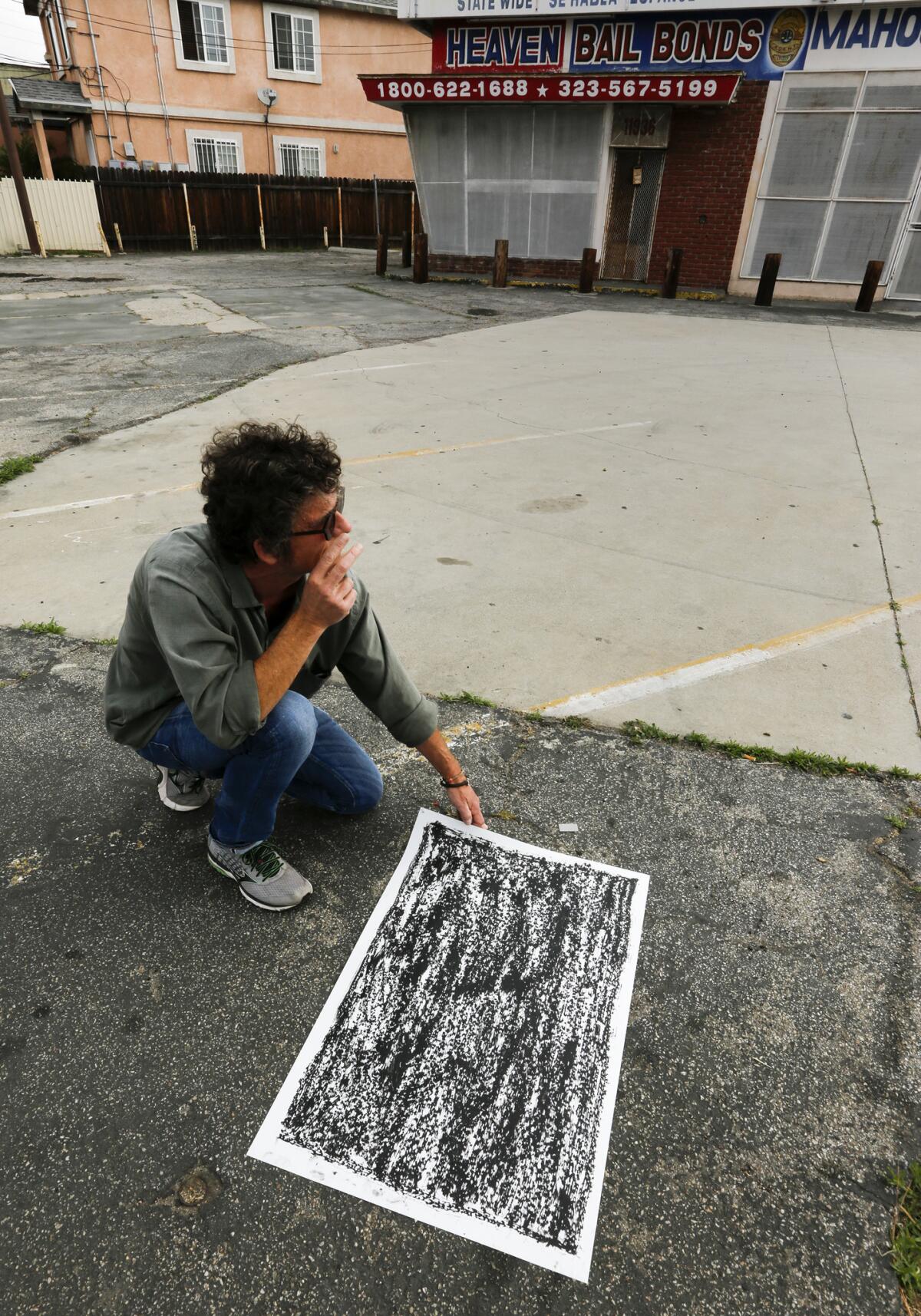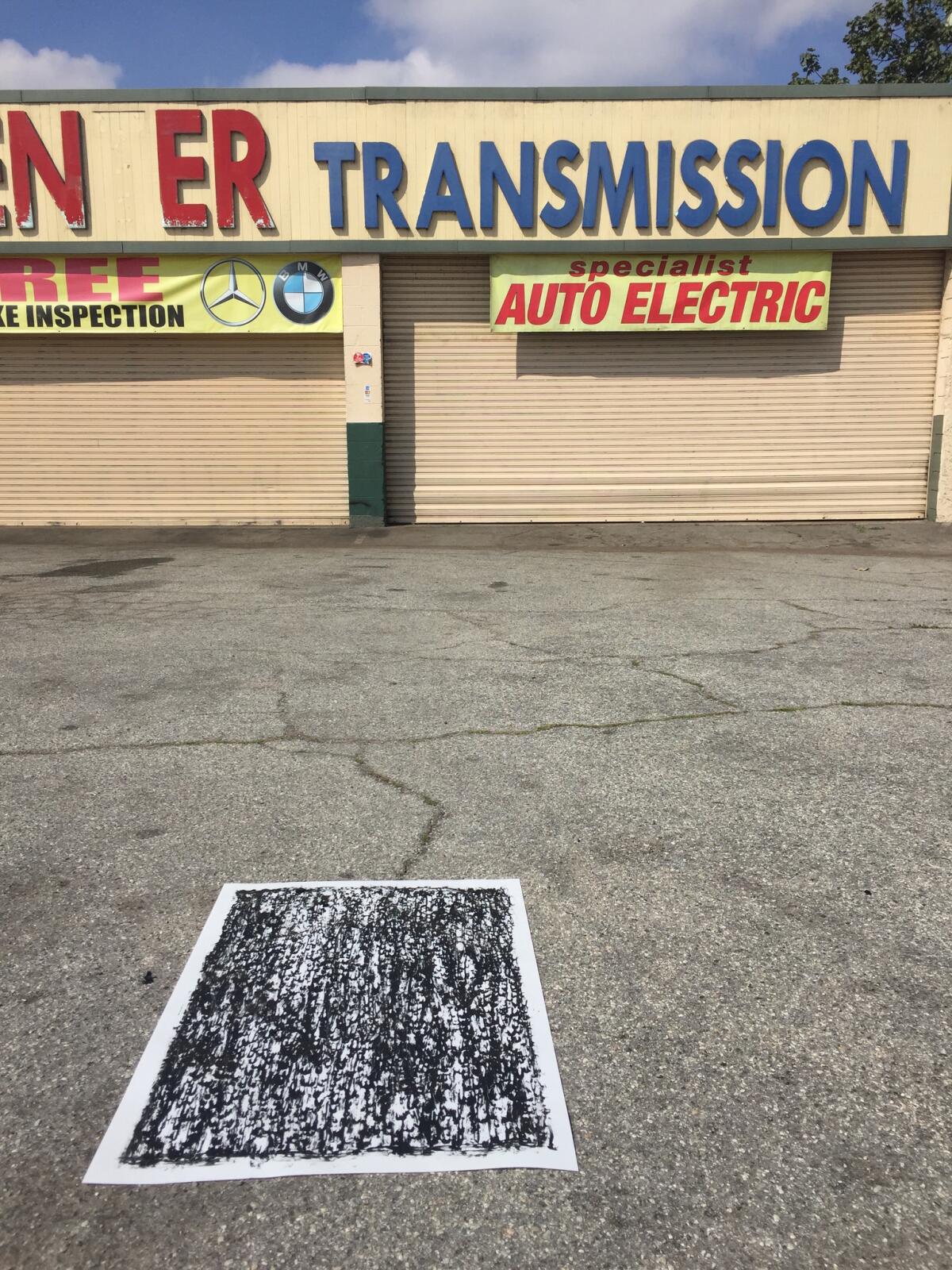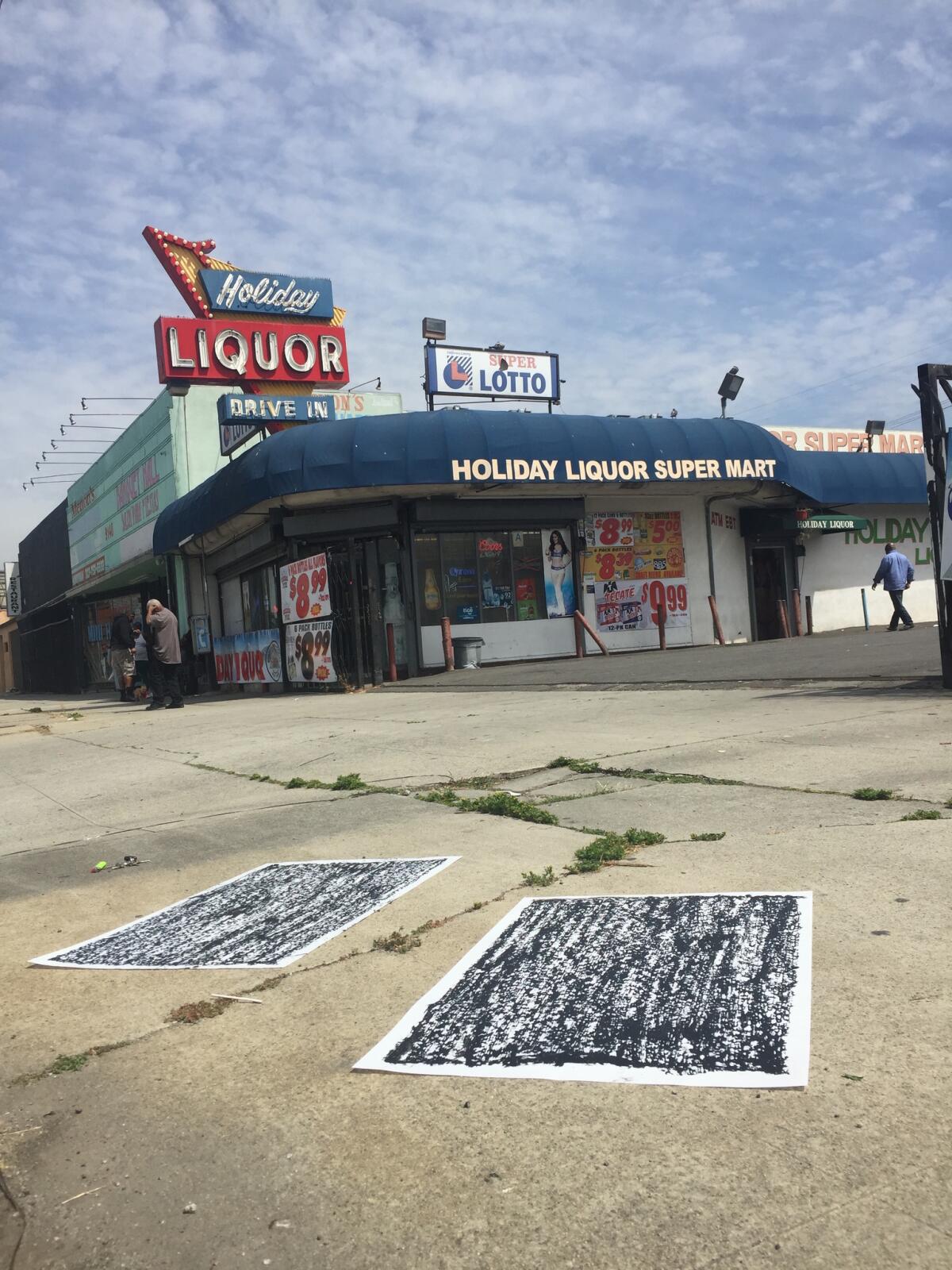Of the 63 people killed during ’92 riots, 23 deaths remain unsolved — artist Jeff Beall is mapping where they fell

Jeff Beall was on his way to a basketball game when Los Angeles began to crackle and burn in wake of the
It was a warm Wednesday afternoon, April 29, 1992, and four LAPD officers had just been acquitted by a Ventura County jury in the excessive force case surrounding King’s beating a year earlier in Lake View Terrace. Beall, his girlfriend and a couple of friends were making their way to Inglewood to watch the Los Angeles Lakers take on the Portland Trailblazers in a playoff game at the Forum.
Listening to the news in the car, says Beall, “We were talking about how outrageous it was. We were saying things like, ‘L.A. is going to burn.’ ”
Little did they know the significance of their words — which became all too evident just minutes after they exited the 110 Freeway at Manchester Boulevard. At the intersection of Figueroa Street, where they stopped for a red light, a restive crowd had gathered. In the middle of the intersection lay something that resembled a piece of engine block.
“I see a guy go pick it up and I see that it’s really heavy, he’s really struggling with it,” says Beall. “He finally picks it up. Then he locks eyes with us and I see that he is going to smash it right through our windshield.”
At that moment, Beall advanced his car into the intersection to avoid the projectile — which nonetheless smashed the car’s A pillar, the metal beam that supports the roof and holds the windshield in place.
“After that, we just blew through the red light,” Beall says.
The experience is one he has been turning over in his mind for 25 years.
“At that point, we could turn around ... and go back through the chaos and try to head home,” he recalls. “Or we could just go straight on and continue onto the Forum. We went straight on.”
It’s so easy to be in the Silver Lake hipster bubble or the Westside bubble or the Hollywood bubble, and you forget how close we really all are.
— Jeff Beall, artist

On a cloudy morning this week, Beall stands at the corner of 120th Street and Central Avenue in the South Los Angeles neighborhood of Green Meadows, just four miles from the place where he and his girlfriend (now wife) dodged a piece of engine.
It’s an unremarkable piece of L.A. urbanscape, with a liquor store, a taco stand and a car wash. On the northeastern corner is a bail bonds agency with the improbable name of Heaven.
At this corner, on the same Wednesday in 1992 that Beall encountered the angry crowd at Figueroa and Manchester, a 23-year-old Latino man named Arturo C. Miranda (no relation) was fatally shot as he was riding home from a soccer game. No one was ever charged in the crime.
Miranda’s death is one of 23 unsolved homicides that took place over the six days of the Los Angeles riots.
For much of the spring, Beall has been traveling to disparate parts of Los Angeles to visit the sites where those 23 people were killed — by accident, by police, by an assailant, by each other. At each site, Beall has draped the ground in a polypropylene sheet (a synthetic material that resembles vellum) and used a black oil stick to create a rubbing of the approximate place where each person fell.
Once the drawing is done, he takes a picture of it in that setting — photos that he refers to as “portraits.” Over the course of the project, he has snapped portraits in front of liquor stores, automotive shops, convenience stores and Heaven Bail Bond.

The rubbings and photographs are for the exhibition “Unsolved: 1992 LA Uprising @ 25 Years” at Gallery 169 in Santa Monica, a show that will run for just six days — marking the same time frame of the riots, from the day the violence broke out April 29 to the moment, on May 4, when then-Mayor Tom Bradley lifted the curfew.
“I think of them as gravestone rubbings,” Beall says of the pieces. “I am not a historian. I’m not a sociologist. I just see this as an interesting way to document the memories of these 23 people.”
More than 60 people lost their lives in the ’92 riots, according to a Times staff report from 2012. But Beall is only interested in the 23.
“It made sense to focus on the ones that are unsolved, that haven’t found that quota of closure,” he says. “And to use that as a focus to make that present for people.”
Like those deaths, many of the social issues that led to the ’92 riots remain unresolved.
Green Meadows, the neighborhood in which we stand, is a community of roughly 30,000. It is also one of the poorest neighborhoods in Los Angeles, with a median household income of a little more than $31,000 a year, according to 2008 census estimates, and a population that is largely black and Latino. In the six-month period from Sept. 5, 2016, to March 5, 2017, there were 360 violent crimes, according to LAPD statistics compiled by The Times. That’s an average of two per day.
These are conditions that Beall has encountered throughout the project.
He did the first rubbing in Pomona, at the site of a drive-by shooting where a 35-year-old black man named Meeker Gibson was killed on May 1, 1992.
“It was my first one, my debut for myself,” Beall recalls. “As I roll up to park, there’s a police action going on at the intersection. There are two cars at an angle and they have someone down in the street.”
I am not a historian. I’m not a sociologist. I just see this as an interesting way to document the memories of these 23 people.
— Jeff Beall, artist

Beall is tall and rugged, with a self-effacing manner. He was born in Santa Ana and received his master’s in fine arts at the California Institute of the Arts. Over the course of his career, he has made work that is about using materials to reveal and conceal and disguise.
In the 1980s, he created a series of paintings that featured photographs mounted on wood panels veiled in gauzy layers of wax. In the ’90s, he created an installation out of paper bags stiffened and hardened with layers of gesso.
“The wall of bags from across the room, they feel like an architectural mass, but when you get up close, they’re just empty paper bags,” he says. “Then you step back and it still retains its power.”
The “Unsolved” series, as he calls the new pieces, nod to a series of abstract works by minimalist Richard Serra, which feature deep layers of black oil stick on paper.
“I’ve always loved those drawings, loved that work,” says Beall. “It did not go unnoticed by my mind that these might carry some reference to that.”
By and large, his pieces have tended toward the abstract, making the “Unsolved” series, as he calls the new rubbings, a bit of a departure, in that they are quite literally connected to specific places and events.
But Beall wants his drawings to carry not just the weight of their stories but also of their pattern and texture and paint — memento mori employed to create a chapel of abstract reflection. (The photographs will be shown separately from the rubbings so they can stand on their own.)
While the work reflects Beall’s long-running preoccupations as an artist, the basis for the series was launched when one of his son’s 14-year-old friends casually asked him if he’d been in Los Angeles during the riots.
“I told her our story, which was more than she expected,” he says. “I could see that it was really very interesting to her, and very affecting … And I started digging up the memories and doing research.”
That research led him to conversations with a curator at the California African American Museum and a police report that listed the 23 unsolved deaths. (Deaths that were mapped by The Times in 2012.)
Beall, who is based in Santa Monica, approached the project as a journey — “a personal pilgrimage,” he says — one that has taken him to Koreatown, Culver City, the San Fernando Valley and South Los Angeles, where we stand.
“Santa Monica is only a 20-minute drive away from here,” he says. “We are much closer than anyone seems to feel. Yet it’s so easy to be in the Silver Lake hipster bubble or the Westside bubble or the Hollywood bubble, and you forget how close we really all are.
“This project, for me, in some small way has fostered conversations with folks with which you wouldn’t otherwise talk.”

Here, for instance, on this corner at 120th and Central, Beall met an older African American man who was not only a witness to the ’92 riots but also remembers the chaotic moments after Miranda was shot that first day.
The man, who declines to provide his name when I arrive there, describes Beall’s project as “a blessing.”
“Over the years, there’s been a death on every corner here,” he says with a sweep of the hand. “[This project], that’s the only way it’s going to get out.”
Beall is aware that being white may open him to criticism for taking on a theme that comments on race and inequity. (Of the 23 unsolved deaths, 16 were of minorities, primarily black and Latino men.)
“I do realize that I’m putting myself out there like that," he says. “But this feels important … We were there and experienced it.”
Ultimately, the project has also allowed him to chew on that defining moment on the corner of Manchester and Figueroa in 1992, as well as the long journey home (he lived in Silver Lake at the time) as entire neighborhoods were aflame.
“We never really did take it personally,” he says of the incident. “It was awful and terrible and completely [messed] up. But it was also arbitrary and not personal in the least. We were all victims of circumstance.”
+++
“Unsolved: 1992 LA Uprising @ 25 Years”
Where: Gallery 169, 169 W. Channel Road, Santa Monica
When: Opens Saturday and runs through May 4
Info: gallery169.com
Sign up for our weekly Essential Arts & Culture newsletter »
ALSO
Netflix's 'Rodney King' has Spike Lee and his muse looking back
'History happened here': Oscar winner John Ridley revisits the 1992 riots in his new documentary
Trio of L.A. riot documentaries look back to 1992
Angelenos talking to Angelenos: Covering the L.A. riots when local news still mattered
John Singleton looks back on the 1992 L.A. riots in new documentary
The biggest entertainment stories
Get our big stories about Hollywood, film, television, music, arts, culture and more right in your inbox as soon as they publish.
You may occasionally receive promotional content from the Los Angeles Times.








